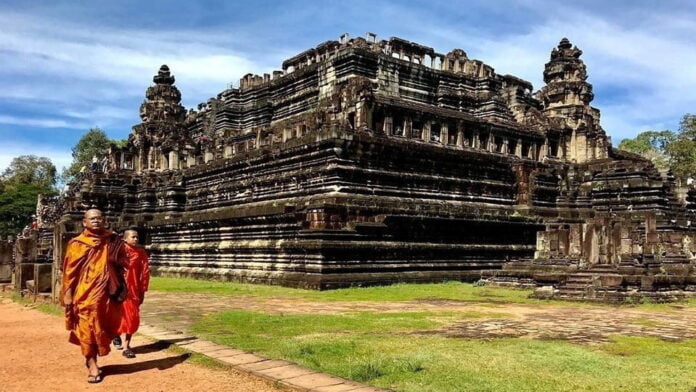Baphuon is a beautiful 11th century “temple-mountain” with steep stairs leading visitors to a terrace which offers one of the best views in the Angkor Archaeological Park. Archaeologists believe that this pyramid-style temple, located within the city of Angkor Thom, was probably among the most impressive of the Angkor temples in its day. Unfortunately, the ravages of time and Mother Nature caused significant damage to this magnificent temple, and it was very nearly lost to history. The tale of how it was restored is just as impressive as the structure itself.
Why and When You Should Visit
Visit Baphuon for the spectacular view of Angkor Thom. You’ll approach the temple along a 225m elevated sandstone walkway, passing through a pavilion about halfway along the walkway which will bring you to the main temple. You’ll get a bit of a workout as you climb the steep stairs to the next levels. Keep the temple on your right as you stroll around and enjoy the beautiful carvings and the amazing views. Try to visit Baphuon in the morning or late afternoon as there is no shade available on the long walkway, and the steep climb to the top can be very taxing during the hottest part of the day. Allow at least an hour to explore Baphuon. This will give you enough time to wander around the site and climb to the summit.
Location and How to Get There
Baphuon is part of the Angkor Small Circuit, which takes you to all the “must-see” temples in the Angkor Archaeological Park. It is located within the Angkor Thom complex approximately 200m northwest of Prasat Bayon. Enter from the east – just follow the walkway. You can certainly wander around the park on your own, but hiring a tuk-tuk driver to take you around the Angkor complex is an inexpensive way to efficiently cover more ground and make sure you don’t miss anything in this enormous complex. Contact us to connect you with a safe and reliable tuk-tuk or taxi driver to show you around the park.
Architecture
The Baphuon temple is the prototype for the Baphuon style of design which covers every available surface with intricate carvings. These carvings include both realistic and fanciful depictions of lotus flowers, wild animals and hunters, devata figures, and men in battle. There are also carvings with indirect references to Hindu mythology and scenes illustrating epic poems such as the Ramayana. The sandstone temple-mountain symbolically represents the sacred five-peaked Mount Meru important in both Hindu and Buddhist cosmology. There are three enclosures in the Baphuon temple complex, and the main structure is situated on a high base. With the bronze tower that was part of the original structure it would have been roughly 50 meters high, but without this tower it stands 34 meters tall.
History
This magnificent temple was built by King Udayadityavarman II in the middle of the 11th century, before the city of Angkor Thom was established. Originally a Hindu temple dedicated to Shiva, it was converted into a Buddhist temple in the late 15th Century, and a huge reclining Buddha (nine meters tall by 70 meters long) was added to the west side of the temple’s second level around this time.
Like the Leaning Tower of Pisa, Baphuon was built on a too-soft foundation of sandy soil which proved to be inadequate for such an immense structure. This shaky foundation caused the temple to be unstable for most of its history, and it is very likely that large portions had already collapsed by the time it was converted to a Buddhist temple. The stones from the collapsed portion of the structure were utilized in the creation of the reclining Buddha, which is one of the largest in Southeast Asia.
By the early 20th century, Baphuon was on the verge of complete collapse. A massive restoration project began in the 1960s, which involved dismantling the temple stone by stone, reinforcing the foundation, and then re-assembling the structure. 300,000 blocks of stone were labelled and numbered, and carefully arranged in the 10 hectares surrounding the temple site, waiting to be put back together. Unfortunately, the project was abandoned when civil war broke out in 1970, and the plans identifying the stones’ intended location were destroyed by the Khmer Rouge.
A second restoration project, which came to be known as the largest three dimensional jigsaw puzzle in the world, was launched in 1996 under the guidance of the architect Pascal Royère. Modern technology greatly aided in the process, but it still took 16 years to complete the puzzle. The lighter colored stones are the restored pieces. We are truly fortunate to be able to visit this remarkable site, and owe a debt of gratitude to the hundreds of workers responsible for reconstructing this magnificent temple.



